Raizen Bundle
How Does the Raizen Company Thrive in the Energy Sector?
Raízen, a powerhouse in Brazil and Argentina, is reshaping the energy landscape. This joint venture between Cosan and Shell, a leader in sugar, ethanol, and fuel distribution, has quickly become a major player. With a reported US$45.5 billion in revenue in the 2023/2024 harvest year, understanding the Raizen SWOT Analysis is crucial for anyone looking to understand its strengths and weaknesses.
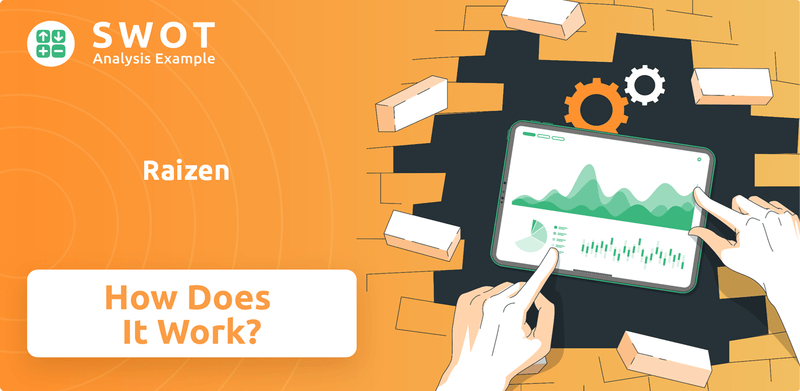
Delving into the Raizen business model reveals an integrated approach, from sugarcane cultivation to fuel distribution, under the Shell brand. This comprehensive overview will explore Raizen operations, its commitment to Raizen sustainability, and the challenges it faces, including recent financial results. Explore how the Raizen company leverages its expansive operations to navigate market fluctuations and drive its vision for the future, particularly in Raizen Brazil.
What Are the Key Operations Driving Raizen’s Success?
The Raízen company operates through an integrated model across three main business lines: Renewables, Marketing & Services, and Sugar. This structure allows it to serve a diverse customer base, from individual consumers at its service stations to industrial clients requiring sugar, ethanol, bioelectricity, and biogas. The company's operations are deeply rooted in Brazil, with a significant presence in the renewable energy and fuel distribution sectors. The Raízen business model emphasizes sustainability and efficiency, aiming to create value through its integrated supply chain and focus on renewable products.
Raízen's core operations involve extensive sugarcane cultivation and processing, with a substantial installed crushing capacity across its plants. The company is a leading producer of ethanol, bioelectricity, and biogas, contributing significantly to Brazil's renewable energy landscape. Its marketing and services division manages a vast network of fuel stations and convenience stores, while the sugar division focuses on producing and commercializing various sugar types for global markets. The company's commitment to sustainable practices and innovative technologies positions it as a key player in the energy transition.
Raízen's value proposition lies in its ability to provide a wide range of products and services, leveraging its integrated operations to achieve economies of scale and operational efficiencies. The company's focus on renewable energy and sustainable practices aligns with global trends, enhancing its market position and appeal to environmentally conscious consumers and investors. The integration of its operations, from sugarcane farming to end-product distribution, provides a competitive advantage, allowing it to offer diverse benefits to its customers and differentiate itself in the market. Learn more about the Growth Strategy of Raizen.
Raízen is a major producer of 1G and 2G ethanol, bioelectricity, and biogas. It has a crushing capacity of up to 105 million tons of sugarcane annually. The company aims to have 20 E2G production units by 2030, with a production capacity of 1.6 billion liters per year.
Raízen operates over 7,000 Shell-branded fuel stations in Brazil and Argentina. It also has over 1,000 convenience stores under the OXXO and Shell Select brands. This division trades approximately 31 billion liters of fuel per year, serving both retail and B2B customers.
This division produces and sells various sugar types, including crystalline, liquid, refined, and organic sugar. It supplies industries like food and pharmaceuticals globally. Raízen's integrated supply chain ensures efficient production and distribution.
Raízen's Bonfim unit is one of the largest biogas plants globally, with a 21 MW installed capacity. It converts agro-industrial waste into electricity and biomethane. This highlights Raízen's commitment to renewable energy sources.
Raízen's operations are characterized by its integrated approach and focus on sustainability. The company's expansion through the incorporation of Biosev in February 2024 significantly increased its sugarcane crushing capacity.
- Leading producer of 1G and 2G ethanol.
- Extensive network of Shell-branded fuel stations.
- Significant biogas production capacity.
- Integrated supply chain from sugarcane to end-product distribution.
Raizen SWOT Analysis
- Complete SWOT Breakdown
- Fully Customizable
- Editable in Excel & Word
- Professional Formatting
- Investor-Ready Format
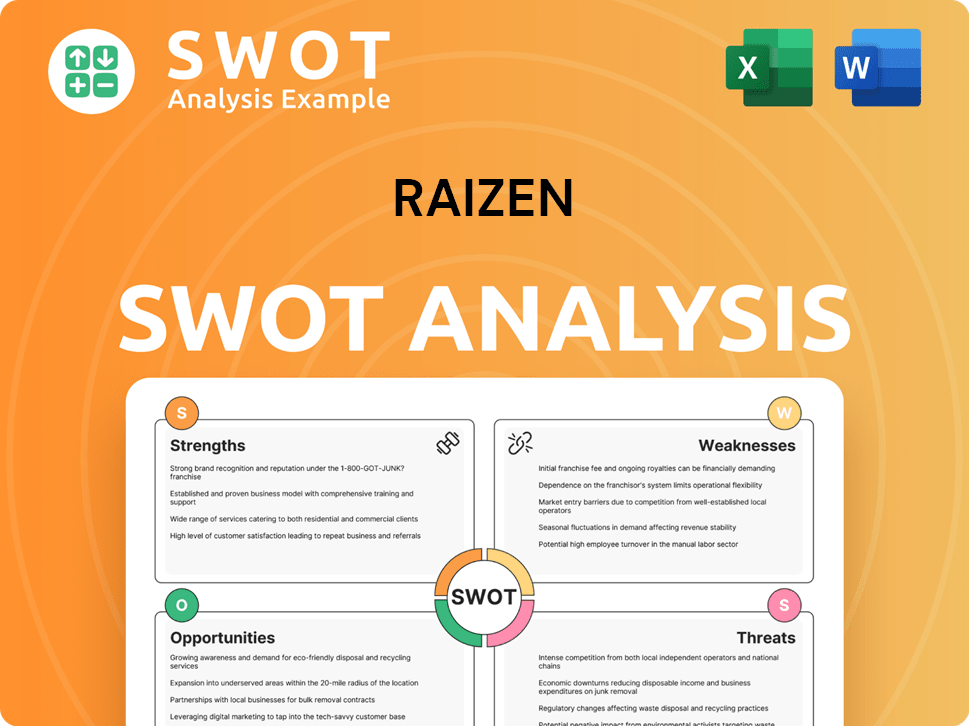
How Does Raizen Make Money?
The revenue streams and monetization strategies of the Raízen company are multifaceted, encompassing various sectors within the energy and agribusiness industries. Raízen's operations are strategically designed to capitalize on opportunities in renewable energy, fuel distribution, and sugar production. The company's approach involves both direct sales and strategic partnerships to maximize profitability.
Raízen's financial performance highlights its robust revenue generation capabilities. For the initial nine months of the 2024/2025 season, Raízen reported total net revenue of R$197.5 billion (approximately US$34.73 billion), marking an impressive 18.5% increase year-on-year. This growth is a testament to the effectiveness of its diverse revenue streams and strategic market positioning. In the third quarter of 2024/2025, net revenue rose 14% to R$66.87 billion (approximately US$11.15 billion), demonstrating sustained momentum.
The Raízen business model is built on three core segments: Renewables, Marketing & Services (Mobility), and Sugar. Each segment contributes significantly to the company's overall financial performance, with specific monetization strategies tailored to the unique characteristics of each sector. The company's ability to adapt and innovate within these segments is crucial to its continued success and market leadership.
The Renewables segment generates revenue from the sale of ethanol (1G and 2G), bioelectricity, and biogas. Ethanol sales are a major contributor, with total ethanol sales reaching 1.274 billion liters between March and May 2024. The company's own ethanol production accounted for 672 million liters of these sales. Revenue from bioelectricity comes from the cogeneration of energy from sugarcane bagasse, with an installed capacity of 3000 megawatts.
The Marketing & Services segment, also known as Mobility, generates revenue primarily from the distribution and sale of fuels and lubricants through its extensive network of Shell-branded service stations and B2B channels. This segment also includes revenue from convenience stores under the OXXO and Shell Select brands. In the third quarter of 2024/2025, the Mobility segment's adjusted EBITDA was R$1.585 billion.
The Sugar segment generates revenue from the production, marketing, and export of various types of sugar. For the first nine months of the 2024/2025 season, the Sugar and Renewables segment's adjusted EBITDA was R$5.469 billion. Raízen's strategic decisions, such as delaying ethanol sales to benefit from higher prices, demonstrate active monetization strategies.
Raízen employs various monetization strategies, including long-term contracts for its 2G ethanol volumes. For example, 80% of the Bonfim plant's 82 million liters annual capacity is already contracted. The company's focus on sustainable practices and renewable energy projects also enhances its market position. Strategic decisions, such as managing sugar stockpiles, further illustrate its active approach to revenue generation.
Raízen's financial results reflect its strong market position and effective operational strategies. The significant increase in total net revenue, along with the growth in adjusted EBITDA across key segments, underscores the company's ability to generate value. The company's commitment to sustainability and innovation, as highlighted in the Marketing Strategy of Raizen, further supports its financial success.
Key revenue drivers include ethanol sales volume, fuel distribution through the Shell network, and sugar exports. The company's ability to optimize these drivers, combined with its strategic decisions regarding production and sales timing, is crucial to its financial outcomes. Raízen's focus on efficiency and market responsiveness is evident in its operational strategies.
Raízen's revenue streams are diverse and strategically managed across its core business segments. The company's ability to generate revenue is supported by its integrated operations and market-driven strategies. The company's commitment to sustainability and innovation, as highlighted in the Marketing Strategy of Raizen, further supports its financial success.
- Ethanol Sales: Significant revenue from 1G and 2G ethanol.
- Bioelectricity: Revenue from cogeneration of energy.
- Fuel Distribution: Sales of fuels and lubricants through Shell stations.
- Sugar Exports: Revenue from the production and sale of sugar.
- Biogas: Sales of electricity from biogas production.
Raizen PESTLE Analysis
- Covers All 6 PESTLE Categories
- No Research Needed – Save Hours of Work
- Built by Experts, Trusted by Consultants
- Instant Download, Ready to Use
- 100% Editable, Fully Customizable
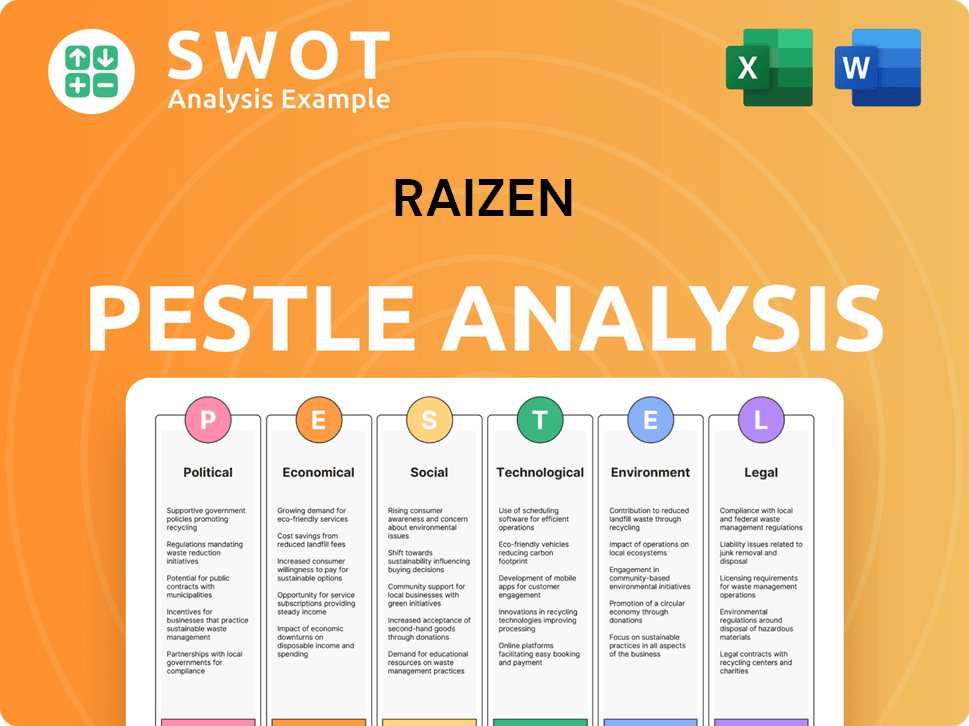
Which Strategic Decisions Have Shaped Raizen’s Business Model?
The Raizen company has achieved significant milestones and strategic moves that have shaped its business model and operations. Its journey began with the operational launch in crop year 2011/2012, following the merger of Cosan and Royal Dutch Shell's assets in Brazil in 2010. Raízen's strategic moves have focused on expanding its sugarcane crushing capacity and enhancing its sustainable energy production capabilities.
A major strategic move was the incorporation of Biosev in February 2024, which significantly expanded Raízen's sugarcane crushing capacity to 105 million tons per year across 35 plants. The company's commitment to renewable energy is evident through the inauguration of new Second Generation Ethanol (E2G) plants, such as the Bonfim Bioenergy Park in May 2024. This park has a production capacity of 82 million liters per year. Raízen plans to operate 20 E2G units by 2030, targeting 1.6 billion liters of annual production capacity.
Raízen's competitive edge is built on its integrated business model, strong brand recognition, and economies of scale. The company is one of the largest sugar and ethanol producers globally. Its proprietary 2G ethanol technology and commitment to sustainability provide a significant advantage in the growing market for low-carbon solutions. Raízen continues to adapt by streamlining operations, optimizing its asset portfolio, and focusing on core businesses to enhance efficiency and shareholder value.
The operational launch in crop year 2011/2012 marked a significant beginning for Raízen. The incorporation of Biosev in February 2024 expanded sugarcane crushing capacity. The inauguration of the Bonfim Bioenergy Park in May 2024 further solidified its position in advanced biofuels.
Raízen's strategic moves include expanding crushing capacity and investing in renewable energy. The company plans to operate 20 E2G units by 2030, with five plants under construction expected to launch between 2024 and 2025. Securing R$1 billion in BNDES funding in January 2025 supports its E2G unit in Andradina.
Raízen's competitive advantages include an integrated business model, strong brand recognition, and economies of scale. The company's proprietary 2G ethanol technology and commitment to sustainability provide a significant edge. Strategic partnerships, such as with BYD, demonstrate its adaptability.
Adverse weather conditions, including droughts and wildfires in August 2024, impacted sugarcane crushing volumes. Raízen announced a reorganization in May 2025, focusing on debt reduction and prioritizing profitable segments. The company is also looking at divesting assets.
The third quarter of the 2024/2025 harvest season saw a net loss of R$2.57 billion. Sugarcane crushing volumes decreased by nearly 27% in the third quarter of 2024/2025 and by 7% year-on-year for the 2024/2025 crop year, which ended with 78.3 million tons crushed.
- Raízen aims for 1.6 billion liters of annual E2G production capacity by 2030.
- The Andradina E2G unit will have an annual production capacity of up to 82 million liters.
- Raízen plans to generate R$10 billion to R$15 billion from asset divestitures.
- The company is focusing on bioenergy, ethanol, sugar production, and fuel distribution.
Raizen Business Model Canvas
- Complete 9-Block Business Model Canvas
- Effortlessly Communicate Your Business Strategy
- Investor-Ready BMC Format
- 100% Editable and Customizable
- Clear and Structured Layout
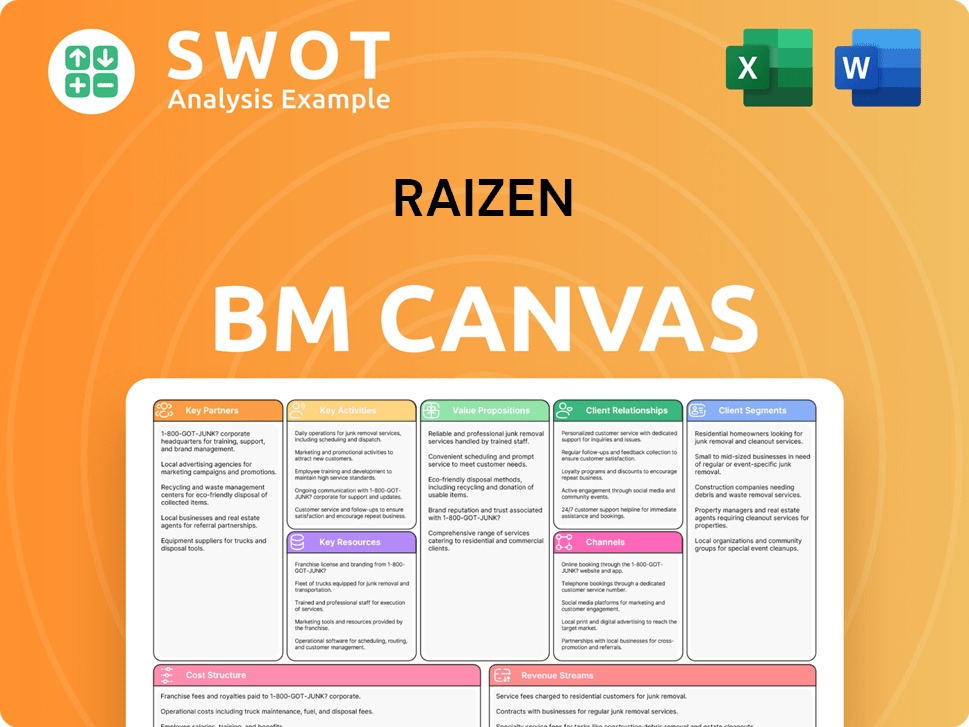
How Is Raizen Positioning Itself for Continued Success?
The Raízen company holds a significant position in the Brazilian energy market. It is the third-largest Brazilian energy company by revenue and the fifth largest company overall in Brazil. As the world's largest sugarcane processor, Raízen business model includes being a leading producer of sugar and ethanol, with a vast distribution network, including over 7,000 Shell-branded fuel stations in Brazil and Argentina. This strong presence highlights its considerable market share in fuel distribution and positions it as a key player in the energy sector.
Despite its strong market position, Raizen operations face several risks. These include operational challenges from adverse weather, such as droughts and wildfires, which impact sugarcane crushing volumes. Financial risks involve debt pressures and rising interest rates, which contributed to a net loss of R$2.5 billion for the fourth quarter of the 2024/2025 fiscal year. Regulatory changes and fluctuations in commodity prices for sugar and ethanol also pose ongoing risks. Competition in renewable energy and technological disruptions could also impact future performance.
Raízen ranks as the third-largest Brazilian energy company by revenue. It is the world's largest sugarcane processor and a leading producer of sugar and ethanol. With over 7,000 Shell-branded fuel stations, it has a strong market presence in fuel distribution.
Operational challenges include adverse weather affecting sugarcane production. Financial risks involve debt pressures and rising interest rates. Regulatory changes and commodity price fluctuations also pose risks. Increased competition in renewable energy is another factor.
Raízen is focusing on its core business, operational simplification, and cost reduction. The company plans to reduce debt and expand margins in the ethanol sector. It is investing in second-generation ethanol (E2G) plants.
Raízen aims to reduce Scope 1 and 2 emissions to near zero by 2025. It plans to decrease the carbon footprint of ethanol and sugar production by 10% by 2030. This commitment strengthens its industry standing in bioenergy.
Raízen is undertaking a new phase focused on its core business, operational simplification, and cost reduction. The company is aiming to decrease consolidated debt and expand margins in the ethanol sector. Asset divestments are planned to generate R$10 billion to R$15 billion to reduce gross debt.
- Raízen is investing in second-generation ethanol (E2G) plants, with a long-term goal of 20 units producing 1.6 billion liters annually.
- The leverage ratio jumped to 3 times EBITDA in the third quarter of 2024/2025, up from 1.9 times a year earlier.
- The company's commitment to sustainable aviation fuel (SAF) and green hydrogen is part of its strategy.
- For more information about the company's target market, read the article about the Target Market of Raizen.
Raizen Porter's Five Forces Analysis
- Covers All 5 Competitive Forces in Detail
- Structured for Consultants, Students, and Founders
- 100% Editable in Microsoft Word & Excel
- Instant Digital Download – Use Immediately
- Compatible with Mac & PC – Fully Unlocked
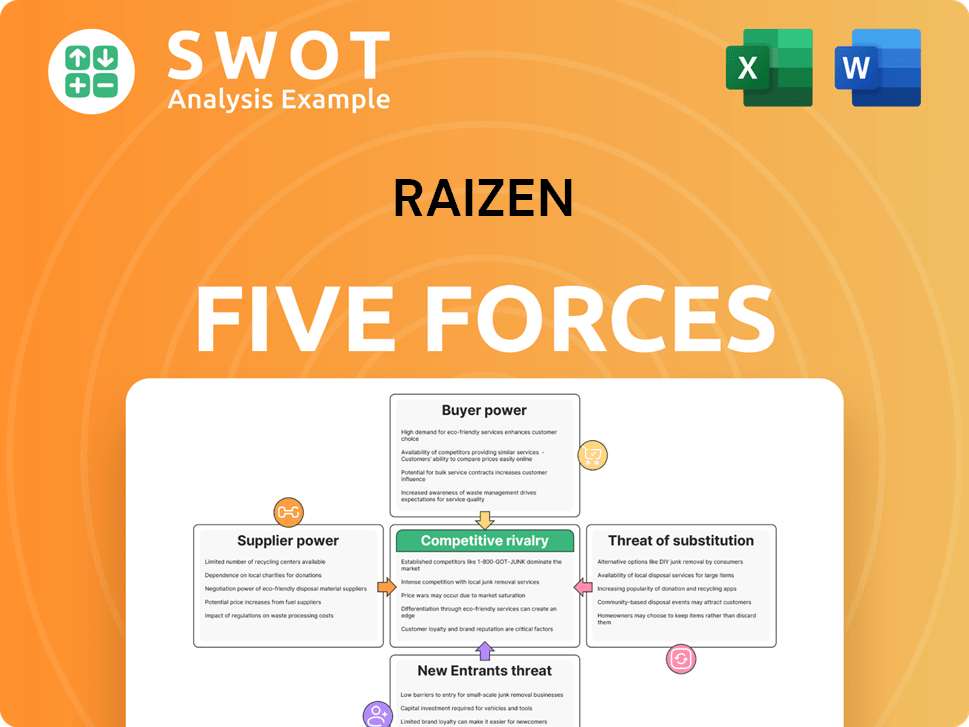
Related Blogs
- What are Mission Vision & Core Values of Raizen Company?
- What is Competitive Landscape of Raizen Company?
- What is Growth Strategy and Future Prospects of Raizen Company?
- What is Sales and Marketing Strategy of Raizen Company?
- What is Brief History of Raizen Company?
- Who Owns Raizen Company?
- What is Customer Demographics and Target Market of Raizen Company?
Disclaimer
All information, articles, and product details provided on this website are for general informational and educational purposes only. We do not claim any ownership over, nor do we intend to infringe upon, any trademarks, copyrights, logos, brand names, or other intellectual property mentioned or depicted on this site. Such intellectual property remains the property of its respective owners, and any references here are made solely for identification or informational purposes, without implying any affiliation, endorsement, or partnership.
We make no representations or warranties, express or implied, regarding the accuracy, completeness, or suitability of any content or products presented. Nothing on this website should be construed as legal, tax, investment, financial, medical, or other professional advice. In addition, no part of this site—including articles or product references—constitutes a solicitation, recommendation, endorsement, advertisement, or offer to buy or sell any securities, franchises, or other financial instruments, particularly in jurisdictions where such activity would be unlawful.
All content is of a general nature and may not address the specific circumstances of any individual or entity. It is not a substitute for professional advice or services. Any actions you take based on the information provided here are strictly at your own risk. You accept full responsibility for any decisions or outcomes arising from your use of this website and agree to release us from any liability in connection with your use of, or reliance upon, the content or products found herein.